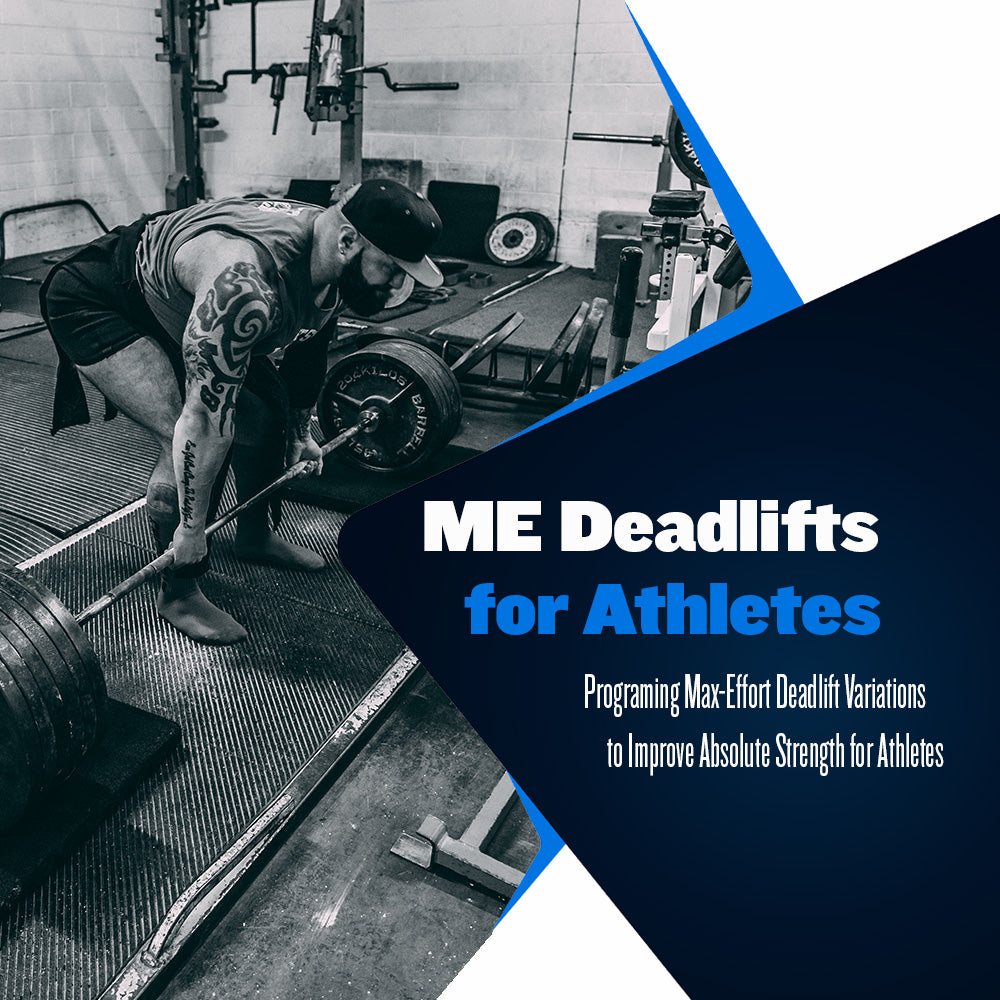Max Effort Deadlift Variations for Athletes

As an athlete, one of the most important attributes you can develop is your absolute strength. Today, many coaches dispute the need for max effort training. These coaches will say that max effort training places an athlete at an increased risk of injury, or that their sport does not require an athlete to be “that strong”.
The truth is that an athlete can never be too strong. Max effort training delivers many additional benefits aside from being able to lift heavy weights for 1-3 repetitions. Want to jump higher? Increase absolute strength. Want to sprint faster? Increase absolute strength. Absolute strength development is something coaches should focus on, considering it improves all other strengths and enhances durability and resiliency.
One of the most effective ways to improve posterior chain strength is by performing deadlift variations. The deadlift is an often misunderstood exercise when applied to athletes. Heavy deadlifts are one of the most effective ways to recruit maximal motor units, and will allow an athlete to strengthen their back, glutes, hamstrings, and trunk quickly.
Where most coaches go wrong is how they go about programming deadlifts for their athletes. It is no secret; heavy deadlifts are taxing. This is what makes them so effective. However, taking this into account, we must program accordingly.
At Westside, we program a max effort deadlift variation for our athletes once every three weeks. Our typical max effort lower exercise rotation will feature a squat variation one week, a deadlift variation the next week, and a good morning variation the final week before cycling back through. This provides adequate amounts of recovery time, considering it can sometimes take up to three weeks to recover from a heavy deadlift depending on the athlete.
Here are a few of the common exercises we select when performing max effort deadlifts at Westside Barbell:
Mat / Block Deadlifts
Limiting overall range of motion can be a great way to expose the body to higher levels of intensity while limiting the overall amount of work the body has to perform to complete the lift. Mat deadlifts are one of the best ways to incorporate a limited range of motion deadlift exercise into your programming.
The intention with mat deadlifts is to place a specific emphasis on the glutes, low back, and trunk. For most, the advantageous joint angles provided by the elevated barbell will allow for more weight to be lifted as well. Increased weight means increased effort, which ultimately means increased motor unit recruitment.
When programming mat deadlifts we will typically perform them for 1-3 repetitions with the bar elevated 2-4” off of the ground. Our recommendation is to find the height that allows your athletes to have their torso as vertical as possible to limit the amount of shear force placed onto the spine.
Deadlifts vs. Minibands
Adding minibands to your deadlifts is one of the best ways for athletes to train at max effort intensities while controlling how the weight is “loaded” onto the body. Bands provide added force as a lifter moves through the range of motion, meaning less force is experienced off of the floor, and more force is experienced as you reach lockout.
This allows an athlete to lift the heaviest amount of weight at the most advantageous joint angles. We do not need an athlete to be able to deadlift a max weight in a powerlifting competition, we need to improve their absolute strength as safely and efficiently as possible. Reducing the strain off of the floor and increasing the strain near lockout is a great way to safely improve absolute strength.
When programming max effort deadlifts versus minibands we will typically work up to a max effort single. It is recommended to leave a set in the tank, there is no need to test the limits with this exercise.
Deficit Deadlifts
When it comes to building brute strength, few exercises can compare to the deficit deadlift. What makes this exercise so effective for athletes is the glute and hamstring strength benefits it can provide. With the range of motion being extended, a greater demand is placed on the glutes and hamstrings to move the barbell.
At the most strenuous point (breaking the floor) the glutes will be even more involved than they would be during a conventional deadlift, as are the hamstrings and low back. As we know, developing the strength of these muscles will ultimately lead to improved sports performance. With any sport played on two feet, your glutes and hamstrings will play a tremendous role in terms of explosive power and run speed.
When programming deficit deadlifts it is best to go with a 2” deficit. This will be feasible for most athletes without having to worry about making any adjustments to their typical deadlift form to reach the barbell.
If you begin to pull from deficits above 2” athletes will begin having to make adjustments to their form, which can increase the likelihood of injury. The goal isn’t to test how much an athlete can deadlift from the greatest deficit, the goal is to extend the range of motion slightly in order to target muscle groups that have a great impact on sports performance.
As far as reps go, we will always work up to a max effort single, while leaving a set or two in the tank. A good rule of thumb for coaches to follow is to end the exercise once you see a breakdown in form. The idea is to reap the maximum amount of absolute strength benefits from this exercise in a safe manner, not to roll the dice.
Absolute Strength for Sports
No matter what the training focus is, your ability to improve your athletes will always be dictated by the quality of the programming, and the quality of the movement execution. Max effort training has been labeled dangerous by individuals who have a very limited training toolkit, and practically no experience lifting heavy weights.
Many strength and conditioning coaches get lost in the idea that in order to become a better athlete you must constantly perform exercises associated with speed training. However, you have to ask, if these exercises are so effective why haven’t injury rates declined? You see it season after season, knee and hamstring injuries happening on a regular basis at the college and pro level.
Want to lower the chances of knee injuries? Improve your hamstring strength by loading them with max effort weight. Want to improve muscle and tendon density? Load them with max effort weight. No matter how many hops, skips, and jumps you perform, nothing can match the athletic benefits associated with gains in absolute strength.
Sources:
Simmons, L. (2007). Westside Barbell Book of Methods. Westside Barbell.
Verkhoshansky, Y., & Siff, M. C. (2009). Supertraining. Verkhoshansky.





